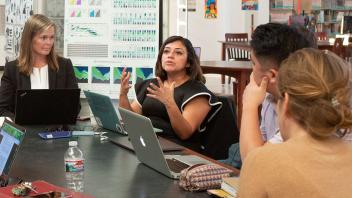Adult learners, like children, need to inquire, reflect, and respond to new ideas if they are to embrace them. Making sense of experience and transforming professional knowledge into daily teaching habits takes time. Teachers need to implement practices they understand and that help them attain goals; otherwise, what is learned will be forgotten when a new trend comes along.
For a teacher to learn a new behavior and effectively transfer it to the classroom, several steps are involved:
- Understand the theory and rationale for the new content and instruction.
- Observe a model in action.
- Practice the new behavior in a safe context.
- Try out the behavior with peer support in the classroom.
Many successful attempts may be needed before the new behavior feels comfortable and well learned. Moreover, an individual teacher’s efforts to improve practice are much more likely to succeed and persist if they are part of a schoolwide and, ideally, districtwide effort.
At present, teachers often expect that change will be mandated from an administration that is distant from their needs and problems. Departure from this norm would be a great step forward. To engage teachers more fully in their own professional development, the following conditions of change, growth, and learning should be respected:
- Change occurs in definable stages.
- A variety of professional development activities will meet individual needs better than a “one-size-fits-all” approach.
- Self-evaluation is part of an individual professional development plan.
- After initial concentrated work, follow-up consultation and classes are offered.
- Sufficient time is allowed before the outcomes of a professional development program are determined.
Ideas need to be incubated before people are ready to act on them. In the case of reading instruction, foundation knowledge concerning reading development, the structure of English, and the research on instruction are essential.
Such foundation knowledge and research should be studied and discussed before a major change in behavior is expected of teachers. For example, spring seminars might precede a new program implementation in the fall. Summer coursework could involve intensive learning of content, leading into gradual introduction of reading instruction changes as the school year progresses.
Professional development programs should consider the fact that teachers’ needs vary. Options could include study groups, collaborative teams, individual projects, peer observations, demonstrations, apprenticeships, classroom research projects, observations and feedback from those who are more expert, and pilot programs. These activities should be grounded in clear statements about the goals, content, and practices of evidence-based reading instruction. The content and practices that are most likely to result in better student outcomes do not need to be reinvented, but teachers will prefer some choice as to how, and in what order, that knowledge and skill is acquired.
Teachers’ previous education, experience, interests, and aptitudes will vary. In a culture of collaborative learning it should become the norm for teachers to identify the ways in which they need to improve. The starting point for teachers’ self-evaluation should be objective assessment of students for the purpose of improving student performance. If teachers identify an important aspect of student learning that is not being well taught, they can work together to design their own professional development activity.
Learning to teach involves learning a large repertoire of skills and exercising judgment about when to use what, with whom, and why. New teaching skills must be practiced and refined with support and coaching. Coaching?which may be provided by peers, content experts, or supervisors?is an important aspect of professional development. Sustained contact with teachers who are learning new skills and when to apply them should be part of the long-range plan.
Again, a long-range vision for school change and instructional improvement may include three to five years of work toward a common goal, although measurable progress should be expected every year. That goal should reasonably assume that fewer than five percent of the student body will experience reading difficulties that require long-term special services. Student achievement tests and portfolios, classroom observations, curriculum-based measures, individual case studies, and teacher surveys will all have a role in determining if the professional development program is effective.
Copyright © 2000 by the Learning First Alliance. Learning First Alliance member organizations include: American Association of Colleges for Teacher Education, American Association of School Administrators, American Federation of Teachers, Association for Supervision and Curriculum Development, Council of Chief State School Officers, Education Commission of the States, National Association of Elementary School Principals, National Association of Secondary School Principals, National Association of State Boards of Education, National Education Association, National Parent Teacher Association, National School Boards Association. For more information, see www.learningfirst.org
